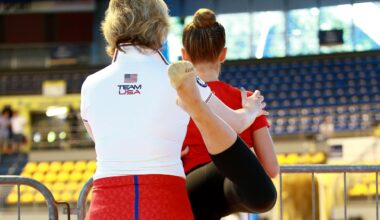Top 5 Boxing Combinations Every Boxer Should Master
Boxing is a sport that requires dedication, skill, and tactical knowledge. Within this art, understanding key combinations can elevate a boxer’s performance significantly. Mastering boxing combinations helps in developing coordination, speed, and overall technique. It can enhance your offensive and defensive capabilities and provide a tactical edge during bouts. Every boxer, whether amateur or professional, must focus on perfecting these combinations to gain confidence and efficiency in the ring. By practicing regularly, boxers can improve their ability to execute punches in fluid motions. Boxers dedicated to honing their craft will notice how these combinations can lead to success in the ring, as they allow for adaptable strategies against different opponents. As part of the training regimen, sparring and shadowboxing can facilitate a better understanding of timing and distance, crucial aspects of performing these combinations effectively. Therefore, let’s delve into some essential boxing combinations that can help any boxer increase their skill set and capabilities. In each section, you will find insights on execution, tips for effective practice, and common mistakes to avoid.
1. Jab, Cross, Hook Combination
This combination is one of the most fundamental in boxing, suitable for beginners and advanced fighters alike. The sequence starts with a quick jab, setting the range and gauging an opponent’s response. Following the jab, the player delivers a powerful cross from the rear hand aimed at the opponent’s chin. The final punch in this combination is a left hook delivered with rotation from the hips. This fluid motion keeps opponents guessing and can lead to knockouts. The success of the jab-cross-hook relies on speed and footwork; thus, proper practice is crucial. To effectively implement this combination, focus on maintaining balance and ensuring each punch flows seamlessly into the next. For training purposes, practice with a partner or heavy bag to build speed and precision. Another variation includes targeting the body instead of the head, which can surprise the opponent. As with any boxing technique, evaluating each punch’s impact and follow-through is vital for optimizing its effectiveness in sparring and fights. With consistent practice, mastering this classic combination can significantly boost your boxing prowess.
2. Uppercut, Hook, Cross Combination. The uppercut, hook, and cross combination, although less conventional, is incredibly effective in close-range scenarios. This combination caters well to boxers who prefer inside fighting, as it capitalizes on short distances. Start with a strong uppercut directed at the opponent’s chin, breaking through their guard. Following this, quickly deliver a crisp hook from the lead hand. Finish the sequence with a powerful cross from the rear hand aimed at the opponent’s head or body. Speed and precision are crucial when executing this combination, as each punch should flow into the next without hesitation. A common mistake is to lean too far forward while delivering the uppercut; this can leave you exposed. Practice this combination during drills, focusing on rhythm and timing. Utilize a heavy bag to perfect the sequence, paying attention to the impact of each punch. Additionally, shadowboxing can help visualize the movement and improve foot placement. Mastery of this combination can open various avenues in the ring, ensuring victory against unprepared opponents. Engage in regular practice sessions for best results.
3. Jab, Uppercut, Jab Combination
This combination effectively disrupts an opponent’s rhythm while blending offensive and defensive techniques. Begin with a steady jab to assess distance and challenge your opponent. Follow immediately with a quick uppercut that can catch them off guard, especially if they are anticipating a jab. Conclude the sequence with another jab which serves to re-establish range and prepare for future combinations. The element of surprise in this combination lies in the uppercut’s placement, as it is often unexpected after jabs. Ensure you keep your guard up following the uppercut to protect against counterattacks. Practice the flow of this combination with both stationary and moving targets to enhance timing and accuracy. Utilize a partner during drills to simulate real match scenarios, which allows for better adaptation and responses. This combination can create openings; thus, maintaining a solid foot position is important throughout execution. Regular practice can solidify muscle memory, ensuring you can throw this combination instinctively during fights. By mastering the jab-uppercut-jab combination, you enhance your attacking versatility in the ring.
4. Body Shot, Cross, Hook Combination. This strategy is beneficial for breaking through an opponent’s defense and creating openings. Start with a powerful body shot to weaken the opponent’s core and disrupt their focus. Follow it up with a cross toward the chin or head. The last component is the hook, aimed at the side of the head or jaw. This combination effectively executes high and low strikes and keeps opponents guessing. Timing and placement are incredibly important; thus, focus on accuracy during practice. Ensure you shift your weight properly during the body shot, allowing for an explosive cross and hook. A common error is throwing the cross haphazardly without solid footing; maintain balance. To enhance this combination, train on a heavy bag to practice targeting and power. Assess each punch’s impact, ensuring you maximize its effectiveness. Considering how body shots can sap energy, using this combination packs a punch in later rounds. In addition, practice this sequence in sparring matches for practical application to build confidence in its execution.
5. Double Jab, Cross, Hook Combination
This combination is ideal for creating distance and disrupting an opponent’s plan. Start with two quick jabs, enhancing your reach while assessing your opponent’s distance and style. The double jab can also serve to protect against counterattacks. Following this, deliver a solid cross aimed toward the head or body, exploiting the openings created by the jabs. Finish the sequence with a swinging hook that connects cleanly with your opponent’s chin or temple. The change in rhythm plays a vital role in this combination’s success; keeping the opponent on their toes can lead to significant openings. To practice effectively, work with a partner or heavy bag, focusing on timing and impact. A common mistake is to lose form during the combination; ensure you maintain proper stance throughout. Repeated drills can improve both speed and execution. This combination adapted for defensive tactics enhances its utility in matches. Overall, committing this combination to memory will heighten your chances of victory.
In conclusion, mastering these five boxing combinations can be transformative for any boxer’s skill set. Every boxer should focus on integrating these combinations into regular workouts and practice sessions. Boxing training isn’t solely about developing physical strength; it also emphasizes mental agility and technique. Each combination opens pathways for strategic thinking, allowing fighters to adapt and outmaneuver their opponents effectively. Practice diligently but also prioritize the quality of execution over mere repetition. When these combinations are blended naturally into your workout, they evolve from techniques into second-nature reflexes. Remember that the aim of practicing these combinations is to build confidence, sharpen reflexes, and elevate performance in the ring. Don’t hesitate to seek feedback from coaches or training partners on your execution. Engage in sparring to apply what you’ve learned in a controlled environment. By committing yourself to improvement and hard work, you will undoubtedly see enhancements in your boxing skills. With patience, commitment, and focused practice, these combinations will significantly elevate your fight strategy and effectiveness.
It is essential to understand that boxing, much like any martial art, is an ongoing journey of self-improvement. Each training session presents an opportunity for learning and growth, both physically and mentally. By dedicating time to perfecting the combinations outlined above, boxers can effectively enhance their fighting styles. Remaining adaptable and open to new techniques can pave the road to success in the ring. Practicing these combinations in various scenarios prepares you for different opponents and fighting styles. Visualization techniques can also support this, giving you an edge in predicting potential move sequences during actual bouts. Maintain a journal to track your progress and identify areas of improvement from each session. Seeking out additional resources, such as instructional videos, can complement your practice regime. Online platforms like YouTube host numerous boxing channels offering expert tips and tutorials that can enhance understanding and execution. Always prioritize safety by wearing protective gear during practice. Engaging in community-driven sparring sessions can provide invaluable experience and broaden your perspective on the sport. Embrace the journey and continually strive for excellence in your boxing career.


